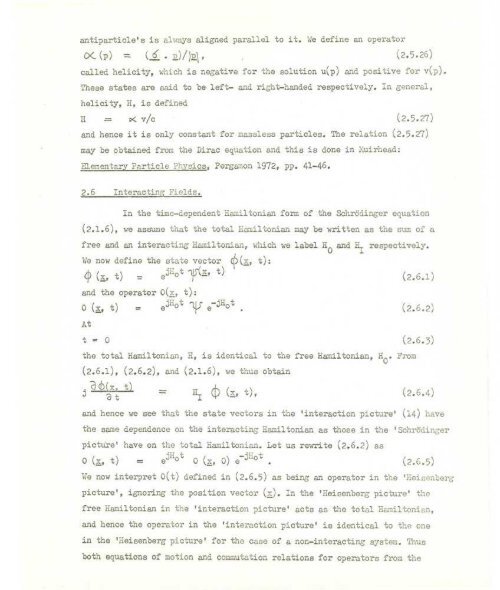introduction-weak-interaction-volume-one
introduction-weak-interaction-volume-one
introduction-weak-interaction-volume-one
Create successful ePaper yourself
Turn your PDF publications into a flip-book with our unique Google optimized e-Paper software.
antiparticle's is always aligned parallel to it . We define an operato r<br />
( p ) (i • 2)/)a\ , (2 .5 .26 )<br />
called helicity, which is negative for the solution u(p) and positive for v(p) .<br />
These states are said to be left- and right-handed respectively . In general ,<br />
helicity, H, is define d<br />
H = o< v/c (2 .5 .27 )<br />
and hence it is only constant for massless particles . The relation {2 .5 .27 )<br />
may be obtained from the Dirac equation and this is d<strong>one</strong> in Huirhead :<br />
ElementaryParticlePhysics, P ergamon 1972, pp . 41-46 .<br />
2 .6 Interacting Fields .<br />
In the time-dependent Hamiltonian form of the<br />
Schrddinger equation<br />
(2 .1.6), we assume that the total Hamiltonian may be written as the sum of a<br />
free and an interacting Hamiltonian, which we label H0 and HI respectively .<br />
We now define the state vector (x, t) :<br />
1) (x, t) = ejHet t) (2 .6 .1 )<br />
and the operator 0(x, t) :<br />
0 (x, t) = ejH ° t' e- ;H°t . (2 .6 .2 )<br />
At<br />
t 0 (2 .6 .3 )<br />
the total Hemiltonian, H, is identical to the free Hamiltonian, H 0 .<br />
(2 .6.1), (2.6.2), and (2 .1.6), we thus obtain<br />
From<br />
J Cl) ( xt t) . 'C() (x, t ) ,<br />
~ gI (2.6.4 )<br />
and hence we see that the state vectors in the '<strong>interaction</strong> picture' (14) hav e<br />
the same dependence on the interacting Hamiltonian as those in the 'Schrddinger<br />
picture' have on the total Hamiltonian . Let us rewrite (2 .6.2) a s<br />
0 (x, t) = e jHot 0 (x, 0) e 0 .<br />
We now interpret 0(t) defined in (2 .6 .5) as being an operator in the 'Heisenberg<br />
picture', ignoring the position vector ( ::) . In the 'Heisenberg picture' the<br />
free Hamiltonian in the '<strong>interaction</strong> picture' acts as the total Hamiltonian ,<br />
and hence the operator in the '<strong>interaction</strong> picture'<br />
(2 .6 .5)<br />
is identical to the <strong>one</strong><br />
in the 'Heisenberg picture' for the case of a non-interacting system . Thu s<br />
both equations of motion and commutation relations for operators from th e



